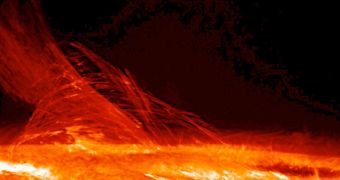The CoRoT satellite, a joint initiative of several European countries and the European Space Agency (ESA), discovered a new Sun-like star, which closely resembles the way our own Sun must have looked like during its early stages of evolution. The new celestial body, dubbed CoRoTExo-2a, is estimated to be about 500 million years old, as opposed to our own star, which is about 4.6 billion years old. A giant planet orbits around the newly-found star, at just 4.2 million kilometers, which makes it revolve around its Sun in just 1.7 days.
During its 150 day-long mission, the CoRoT managed to catch a glimpse at the way CoRoTExo-2a behaves. Astronomers analyzing the feedback found that variations in the intensity of the star are at about 6 percent, which means that it’s at least 20 times more unstable than our Sun. The modulation period for its intensity only spans about 4.5 days, and the variations are mainly caused by spots, similar to those on our Sun, except that they are bigger and in constant expansion and motion.
Although the giant planet orbiting the star obviously cannot sustain life, astronomers from the Italian National Institute for Astrophysics (INAF), at the Catania Astrophysical Observatory, working with colleagues from the Italian Space Agency (ASI), say that studying the enormous magnetic influence that CoRoTExo-2a exerts on it can reveal clues as to how exactly the conditions necessary for evolution of life on Earth came to be.
That is to say, undoubtedly larger solar flares and magnetic disruptions could have easily affected life forms on the Earth, when all there was around was the famous “primordial soup,” filled with basic organisms. Such creatures are very susceptible to any change in their environment, and while some may have outlived the fluctuations in their surroundings, others surely perished. By analyzing the way the young star influences its planet, space experts can shed some light on some of the questions tied to the onset of life in our corner of the Universe.

 14 DAY TRIAL //
14 DAY TRIAL //